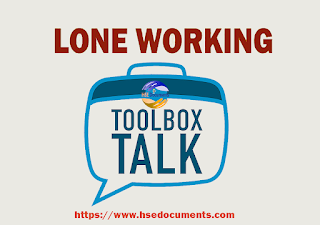To download occupational health safety and environmental free documents in editable format; visit our blog at hsedocuments.com; where you can download all free content. Following are key point taken from the original "LONE WORKING SAFETY TOOLBOX TALKS" file:
1-Objectives
This talk covers the following points:
- To develop and implement a Work Alone Policy.
- What does Working Alone mean?
- To assess the hazards and risks of the work environment.
- To develop, establish health and safety procedures and policies.
- To communication between worker and the supervisor.
2-Introduction:
Employers have the accountability & responsibility to protect and safeguard their employees while at work. This is regardless of whether the employee works alone or with co-workers. OSHA does not have a specific requirement regulating lone workers. However, they do recommend organizations/companies to establish and implement a Work Alone Policy under the [Law & rules of the state/country where the business exists].
3. Discussion:
Most employees carried out job tasks where they must work alone. The term Working alone means “working where you cannot be seen or heard by another person and where you cannot expect a visit from another person during your work assignment.”
Employers should take into consideration/account circumstances when employees work alone. They should assess the hazards of the work environment and develop effective health and safety procedures and policies that address these hazards. The purpose of the hazard and risk assessment is to identify what needs to be done to control and mitigate the occupational health and safety risks for the lone employees. These are basic legal requirements that should be carried out for all workers. The companies with five or more employees are legally required to keep a record of the risk assessment. This should be part of the Work Alone Policy.
It’ important to provide training for lone workers so they understand what is expected of them. It’s essential to have a work procedure that directs them on how to work alone safely. A step-by-step guide should be used until the procedure becomes routine.
Ensure there is contact between the lone worker and the supervisor by phone or two-way radio. Install an automatic warning device that will sound if a signal is not sent and received from a lone worker. Monitoring the health and safety of the lone worker is essential because of limited contact. All POSSIBLE EFFORTS should be made to secure the safety of the lone worker; communication is vital.
Implementing safety measures can reduce the number of work-related injuries and fatalities that pose a risk for employees working alone. Avoid having a lone worker whenever possible.
4-TASKS INVOLVING WORK LONE WITH GREATER RISKS
- Time your tasks carefully to identify with when others are present.
- Seek assistance from persons nearby or your supervisor or manager.
- When you have to work alone, take extra care to ensure that you do not put yourself in
- any unnecessary danger. If you have any doubt about your ability to undertake and fulfil a task safely, do not start the task. Search for further advice from your site supervisor or project manager.
- The activities which must never be undertaken while working alone are those which
- involve any form of entry into a confined space, and (even if you are qualified and competent and experienced to do so) any form of work involving live electrical conductors
- Tasks that could involve risks and which are best avoided when working alone if this is possible, include:
- Welding, burning and other hot work.
- Handling or use of corrosive or dangerous substances/materials.
- Working at height.
- Work involving excessive manual handling.
- Working under vehicles or heavy plants.
5-BUDDY SYSTEM
What Does Buddy System Mean?
“A buddy system is a type of health and safety management practice in which each individual are teamed up and given responsibility and assigning accountability for ensuring each other’s safety”.
It usually describes a mutual arrangement in which both parties are conducting the same hazardous work and have equal responsibility for each other’s safety. However, in some hazardous work or process cases, only one buddy may be assigned to do a task, while the primary responsibility of the other buddy will be to make sure the partner’s safety.
In high-risk, allow the option of a “buddy system” or the use of surveillance cameras for observation. If it’s determined that it’s too much of a risk for a worker to work alone safely, the employer must not allow an employee to work alone under any circumstance.









No comments:
Post a Comment